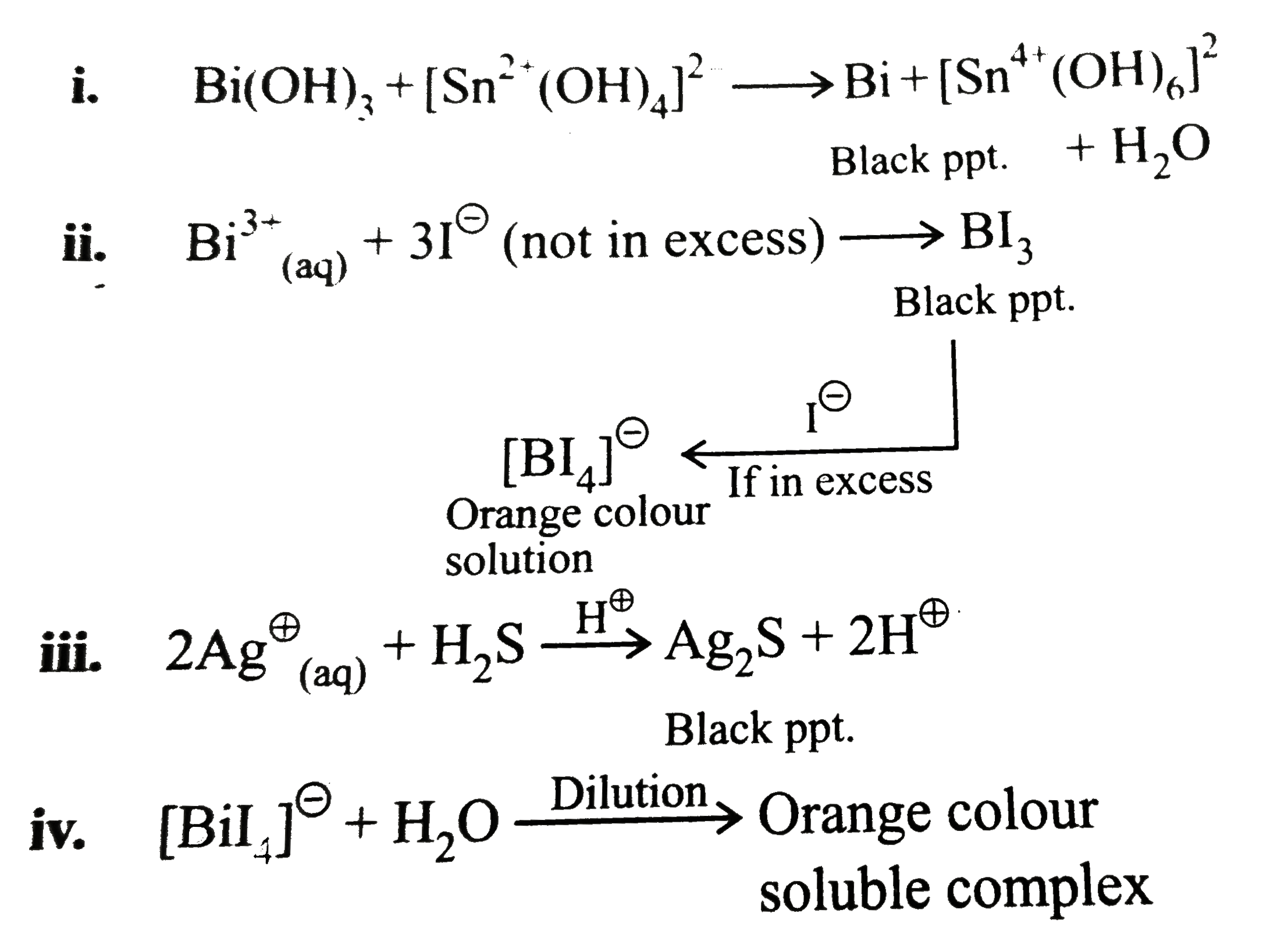In how many of the following reactions, one of the products is obtained is a black precipitate ?
i.Bi(OH)3⏐⏐↓+[Sn(OH)4]2−.(aq)→ Products
ii. Bi3+.(aq)+IΘ.(aq) (not in excess) → Producets
iii. Ag⊕.(aq)+H2S(g)H⊕−−→ Producets
iv. [BiI4]Θ.(aq)+H2O(I)Dilution−−−−→ Products
The correct Answer is:3
Topper's Solved these Questions
- QUALITATIVE INORGANIC SALT ANALYSISBOOK - CENGAGE CHEMISTRYCHAPTER - QUALITATIVE INORGANIC SALT ANALYSISEXERCISE - Exercises (Fill In The Blanks)
42 Videos
- QUALITATIVE INORGANIC SALT ANALYSISBOOK - CENGAGE CHEMISTRYCHAPTER - QUALITATIVE INORGANIC SALT ANALYSISEXERCISE - Exercises (True And False )
20 Videos
- QUALITATIVE INORGANIC SALT ANALYSISBOOK - CENGAGE CHEMISTRYCHAPTER - QUALITATIVE INORGANIC SALT ANALYSISEXERCISE - Exercises (Assertion-Reasion)
9 Videos
- P-BLOCK GROUP 18 ELEMENTS - THE INERT GASESBOOK - CENGAGE CHEMISTRYCHAPTER - P-BLOCK GROUP 18 ELEMENTS - THE INERT GASESEXERCISE - Ex 5.1 (Objective)
14 Videos
- REDUCTION AND OXIDATION REACTION OF ORGANIC COMPOUNDSBOOK - CENGAGE CHEMISTRYCHAPTER - REDUCTION AND OXIDATION REACTION OF ORGANIC COMPOUNDSEXERCISE - SUBJECTIVE TYPE
3 Videos
Similar Questions
In how many of the following reactions one of the products is obtained as a black precipitate ?
(i)Bi(OH)3⏐⏐↓+[Sn(OH)4]2−(aq)→Products
(ii)Bi3+(aq)+I−(aq)(not in excess)→Products
(iii)Bi3+(aq)+H2S(g)H+−−→Products
(iv)[Bil4]−(aq)+H2O(l)dilution−−−→Products
(v)Bi3+(aq)+C9H7ON(5%)+H+(aq)+I−(6M)→ Products
(vi)Bi3+(aq)+C6H3(OH)3(10%)→Products
(vii)BiO.OH⏐↓+H2O2(aq)→ Products
View SolutionIn how many of the following reactions one of the products is obtained as a black precipitate ?
(i)Bi(OH)3⏐⏐↓+[Sn(OH)4]2−(aq)→Products
(ii)Bi3+(aq)+I−(aq)(not in excess)→Products
(iii)Bi3+(aq)+H2S(g)H+−−→Products
(iv)[Bil4]−(aq)+H2O(l)dilution−−−→Products
(v)Bi3+(aq)+C9H7ON(5%)+H+(aq)+I−(6M)→ Products
(vi)Bi3+(aq)+C6H3(OH)3(10%)→Products
(vii)BiO.OH⏐↓+H2O2(aq)→ Products
View Solution
Knowledge Check
In the reaction
H2O2(aq)I−−−→H2O(l)+12O2(g), where I− isAHeterogeneous catalystBHomogeneous catalystCEnzyme catalystDAcid catalystThe Bronsted acids in the reversible reaction are HCO−3(aq.)+OH−(aq.)CO2−3(aq.)+H2O
AOH− and CO2−3BOH− and H2OCHCO−3 and H2ODHCO−3 and CO2−3In the reaction
H2O2(aq)I−−−→H2O(l)+12O2(g), where I− isAHomogeneous catalystBHeterogeneous catalystCInhibitorDRetarder
(iii) H2SO4(aq)+NaOH(aq)→Na2SO4(aq)+H2O(I)
View SolutionComplete the follwing chemical equations for reactions :
(i) Fe∘+(aq)+MnO−4(aq)+H+(aq)→
(ii) Cr2O2−7(aq)+I−(aq)+H+(aq)→.
View SolutionWhat sort of informations can you draw from the following reaction?
(CN)2(g)+2ΘOH(aq)→CNΘ(aq)+CNOΘ(aq)+H2O(l)
View SolutionWhat sort of informations can you draw from the following reaction?
(CN)2(g)+2ΘOH(aq)→CNΘ(aq)+CNOΘ(aq)+H2O(l)
View SolutionCH3COOC2H5(aq)+H2O(l)H+(aq)−−−−−→CH3COOH(aq)+C2H5OH(aq). What type of reaction is this?
View Solution

